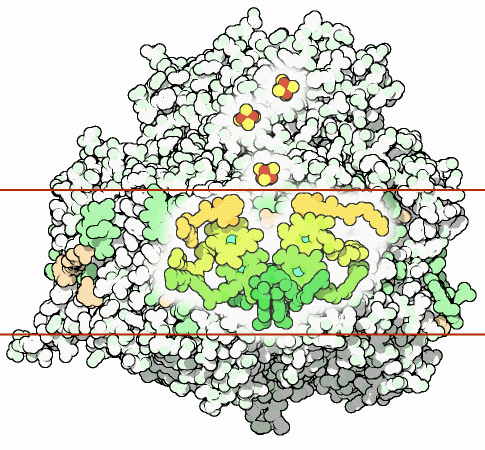|
Inhaltsübersicht | Nanomaschinen | Moleküle | Programme | Kurse | Fun | Links |
||
| > |
Photosystem I
The Electron Transfer Chain
The heart of photosystem I is an electron transfer chain, a chain of chlorophyll (shown in green), phylloquinone (shown in orange) and three iron-sulfur clusters (yellow and red at the top). These cofactors convert the energy from light into energy that the cell can use. The two chlorophyll molecules at the bottom capture the light first. When they do, an electron is excited into a higher energy state. Normally this electron would quickly decay, releasing heat or releasing a new photon of slightly lower energy. But before this has a chance to happen, photosystem I passes this electron on, up the chain of cofactors. At the top, the electron is transferred to a small ferredoxin protein (not shown here), which then ferries it on to the other steps of photosynthesis. At the bottom, the hole left by this wandering electron is filled by an electron from another protein, plastocyanin.This may seem rather mundane until you see the trick that the photosystem is performing. The proteins at both ends of this process, ferredoxin and plastocyanin, are carefully chosen. Because of the special design of their own cofactors, it is more difficult to add an electron to ferredoxin than it is to plastocyanin--normally, the flow would be in the opposite direction. But photosystem I uses the energy from light to energize the electron, moving it in a difficult direction. Then, since the electron is placed in such an energetic position, it can be used to perform unfavorable duties such as the production of sugar from carbon dioxide.
Next: Photosynthetic Cousins
Previous: Photosystem I
Last changed by: A.Honegger,
